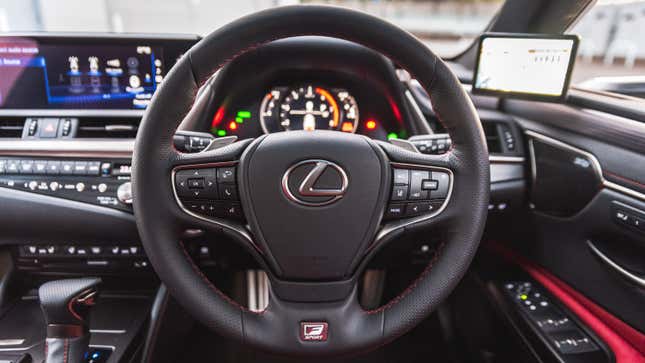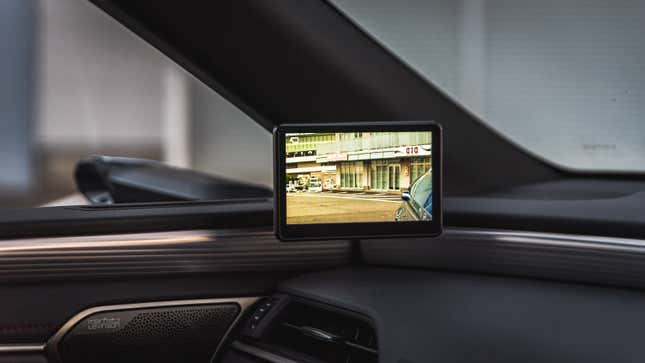The seventh-generation Lexus ES sedan introduced the first mass-produced digital mirror to the world in 2018, beating the Audi E-Tron, Honda E and McLaren Speedtail in replacing traditional side mirrors with cameras. Based on just one night with the digital Lexus ES mirrors, I believe the change to be an improvement.



What Is It?
The Lexus ES isn’t a particularly exciting car. It’s a fine motorway cruiser with a nice relaxing ride. Japan’s Lexus ES comes with the 2.5-liter gasoline-hybrid engine. The bigger 3.5 V6 engine isn’t offered in Japan. As you’d expect for a Lexus, it’s loaded up with safety and convenience features, but the new digital mirrors are the highlight here. As of July 2020 they’re available on F Sport cars. Previously it was limited to the more luxury-oriented trim levels.
The camera and screen setup on the Lexus is rather simple, though admittedly not as simple as a mirror. Two cameras on the exterior replace traditional reflective side mirrors. The digital feed is transmitted to two 5-inch monitors situated at the base of each A-pillar inside the car, facing the driver.
The digital side mirrors are bundled with other features including Parking Support Brake driver assistance for rear pedestrian avoidance and the 360-degree panoramic view monitor. The package costs an additional ¥287,100 ($2,750 U.S.) — about the same price as the optional Mark Levinson surround sound system. It’s not an exorbitant splurge for gimmicky first-generation tech that also kind of works.


Along with the side-view mirrors on the left and right of the car, the rear-view mirror is also digital. It’s actually a trick mirror and can revert back to a traditional mirror at the touch of a button.
Lexus says the cameras are resistant to raindrop stains that may block the image. While I didn’t see rain during my time testing the car, I did notice the images from the cameras stayed clear after giving the ES a wash. I would be interested to see how it performs at low temperatures or with snow and ice — though traditional mirrors can be obstructed in those conditions as well.

Does It Work?
It’s obvious that this is first-generation tech. While the interior 5-inch screens themselves are bright and clear enough in daylight, the camera resolution could’ve been higher, even if judged by the standards of 2018 when the system was released. The seeming lack of resolution may have something to do with the default zoom setting. The camera zooms out for a better look when you indicate to turn or change lanes and the temporary zoomed-out feed is much clearer. I could not find a system setting to have the image remain zoomed out without triggering the indicators. I had no issues with lag or delays with the live feed from the cameras.


Adjusting the camera angle means accessing three menu screens, but it’s worth it. After about half an hour of playing with the car’s settings to get them just right, using the mirrors was closer to second nature. I’d go as far as to say it became more comfortable and intuitive than old-school mirrors.
Lexus claims having smaller cameras instead of boxy mirrors improves driver visibility via the side windows and offers a quieter ride by reducing wind noise. But the setup really shines at night, where the elimination of glare from side mirrors is eliminated. Even if the terrorist behind you has the brights on, the cameras don’t blind you and it is easier to see cars in the distance. Looking at powered screens instead of dull mirrors is also a big improvement.
Another upside is the camera “lock-in” function that puts a massive yellow square on the car’s blind spot (as calculated by the car’s computer) to help the driver detect objects there. A July 2020 update also adds red guidelines next to where the rear wheels are shown on the screen to help you avoid curbing them.

Design
One promised benefit to these types of rear-view camera systems is that designers have more freedom. This ES and the Audi E-Tron both have equipment that seems a bit tacked on instead of integrated into the design concept, including the external cameras and internal screens. Both are essentially using the same mounting points on the vehicle as the traditional mirror counterparts. It makes sense, but it denies the tech of some of its full design potential.


By contrast, the likes of the new Honda E electric hatchback and McLaren Speedtail supercar have cameras that are much better integrated into their designs. On the Lexus, I would’ve preferred for the monitors to have been styled a bit better inside with better shapes and materials.
The A-pillar is where you would think to automatically go for the side mirror screens. However, when I first started driving the car, my eyes went to the cameras outside, where the physical mirrors would be, instead of the monitors. It took some time to adjust my instincts and it may have been easier if they didn’t look like aftermarket nav screens.

Concerns
Reliability is a perfectly reasonable concern given how relatively new the tech is here. That said, this is Lexus and Toyota we’re talking about. The screens look cheap but bulletproof because they probably are.
I don’t believe in advancing technology just for the sake of it, particularly when it comes into conflict with the human elements of design and driving. I don’t think much of that is happening here.


There’s potential for digital side mirrors. It’s certainly the new technological fad in the auto industry, and while current regulations in the United States won’t allow it, many cars in Japan and Europe are being offered with them. All Honda E hatchbacks ship with digital mirrors.
When I got back into a car with traditional mirrors after driving the Lexus ES, I did miss the ease and convenience of the high tech setup, especially at night.
If you’re still asking, “what’s wrong with an old fashioned mirror?” the screen can still be used as a mirror — a black mirror, so reflect on that.

